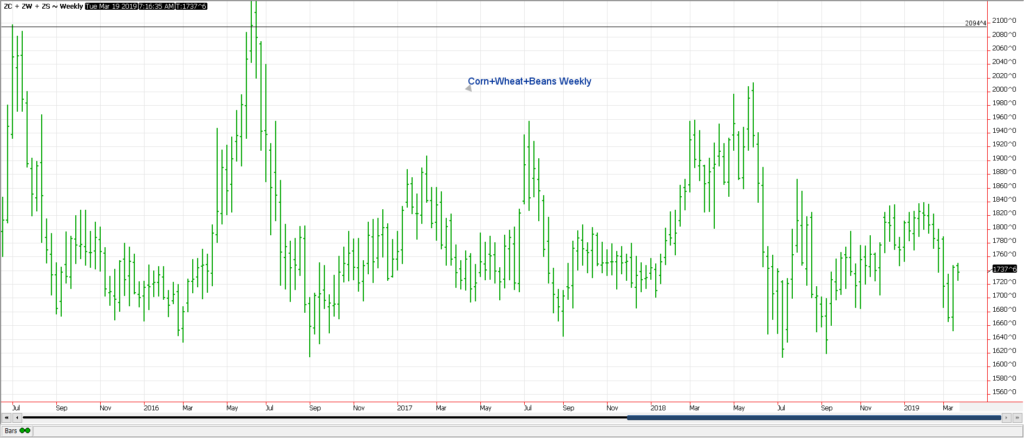By: Dan Hueber –
With the exception of bean oil, prices in the grain and soy complex closed soft yesterday but by no means would you describe the selling as intense and seems reasonable after the posting nice gains all around last week. I would like to point out that in the combination chart, we did post an outside higher reversal last week and while that by no means guarantees that we have slain the bear, I suspect he was wounded enough that he will not be a threat for some time.
Grain/soy specific news is a bit sparse this morning, which could help to at least partially explain the mixed trade. Wheat is higher, corn flat and beans lower, and I would not be surprised to witness a few more days of choppy back and fill type action. While I do not want to rush things, be we are on the downhill side of the month, and we could witness semi-directionless action as we close in on the Prospective Plantings and Grain Stocks estimates to be released on the 29th.
While grain news may be slight, there are more than enough stories concerning hogs. The Ministry of Agriculture and Rural Affairs in China reports that the overall Chinese hog herd is 16.6% smaller than a year ago, totaling 433 million head. That would equate to around 72 million head lower. At the end of February, they report that the sow numbers were down 19.1% and total pig herd down 5.4%. The USDA currently estimates that by the end of this year, the total swine inventory in China will be down to 374 million head. To give you a perspective of the enormity of these changes, according to the December Hog and Pigs report, there was a total of 74.6 million head of hogs in the United States and another 14 million in Canada. So, if the numbers are even close to correct, China will have lost more pigs than the combined inventories of the other two nations. Not only do half of the world’s inventory of hogs reside in China, but it is also where half of the world’s pork is consumed. The Chinese Merchandise Reserve Management Center has announced they will begin buying ASF free pork for government reserves, but it must be raised in China. We shall see how long those requirements hold out. The USDA estimates that China will import 2 MMT of pork this year which will be an increase of 33%.
Of course, the problems with African Swine Fever have not been eradicated in China just yet (1 million head and counting), and the problem now appears to be worsening in Vietnam. The first cases in that nation were reported just a month ago on three farms, and since that time, it has spread to 17 provinces with 239 confirmed outbreaks. Vietnam has around 30 million hogs, and the UN’s FAO has urged the nation to declare a national emergency.
While all of this should be a potential boon for the U.S. hog industry and indeed, we have already seen spot futures advance 34% in the past four weeks, but of course that was from very depressed and unprofitable levels for the industry. This is a two-edged sword though as demand for feedstuffs will be reduced and potentially for some time. I read a comment this morning that an outbreak of African Swine Fever on the Iberian Peninsula back in the 1960s took more than 30-years to eradicate. Granted, geographical difference would suggest that will not be the case today the virus can survive in uncooked pork for extended periods of time, making it all the more challenging to control.
Already, demand for soybeans was tapering in China, and for this coming year, the USDA expects total consumption to be down 1%. It would seem that with Brazil potentially gearing up to increase production, long-term unless we can uncover a new use for soybeans, this paints a somewhat gloomy picture for much improvement in price, particularly without a significant weather disruption somewhere.

